外研版 必修四 Module 2 Traffic Jam Module2 Introduction & Reading and Vocabulary 课件(30张PPT)
文档属性
| 名称 | 外研版 必修四 Module 2 Traffic Jam Module2 Introduction & Reading and Vocabulary 课件(30张PPT) | 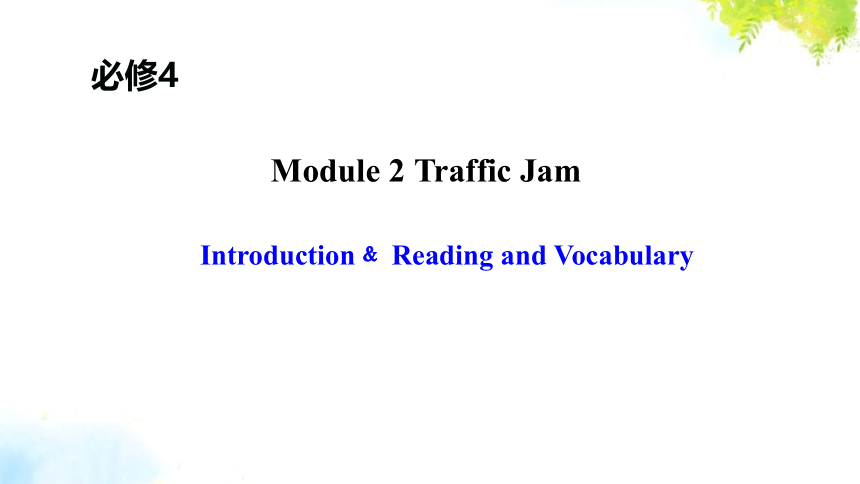 | |
| 格式 | pptx | ||
| 文件大小 | 1.6MB | ||
| 资源类型 | 教案 | ||
| 版本资源 | 外研版 | ||
| 科目 | 英语 | ||
| 更新时间 | 2022-10-18 11:58:17 | ||
图片预览

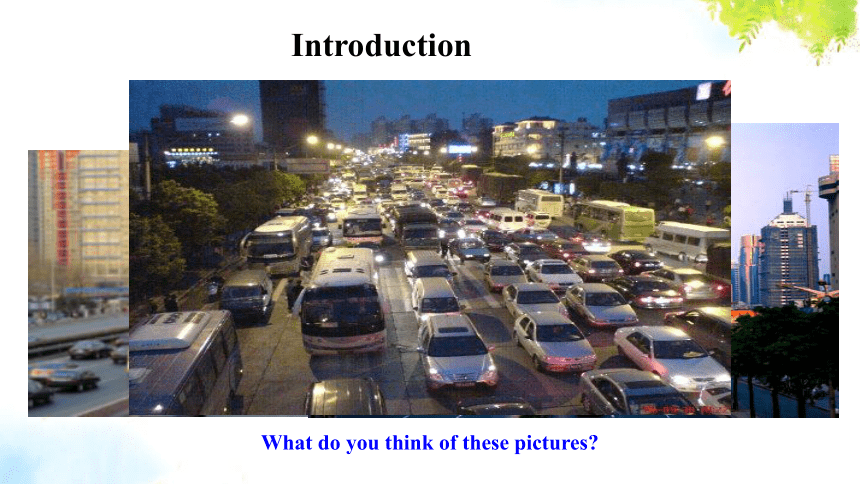
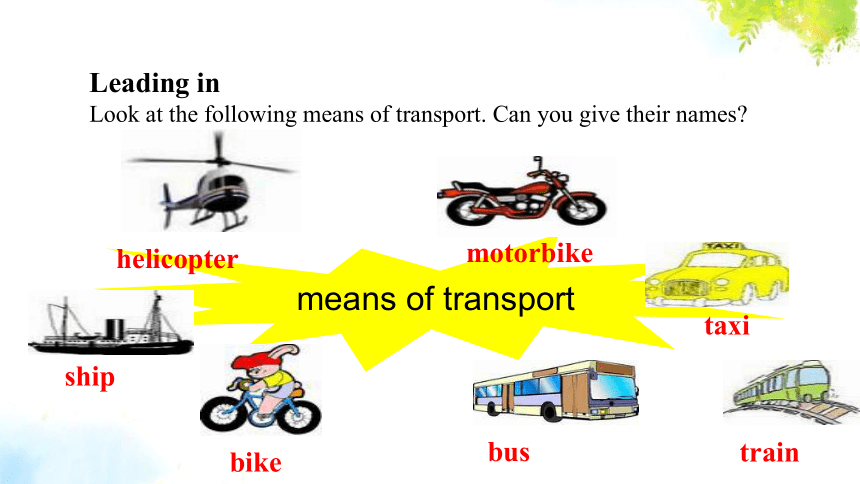
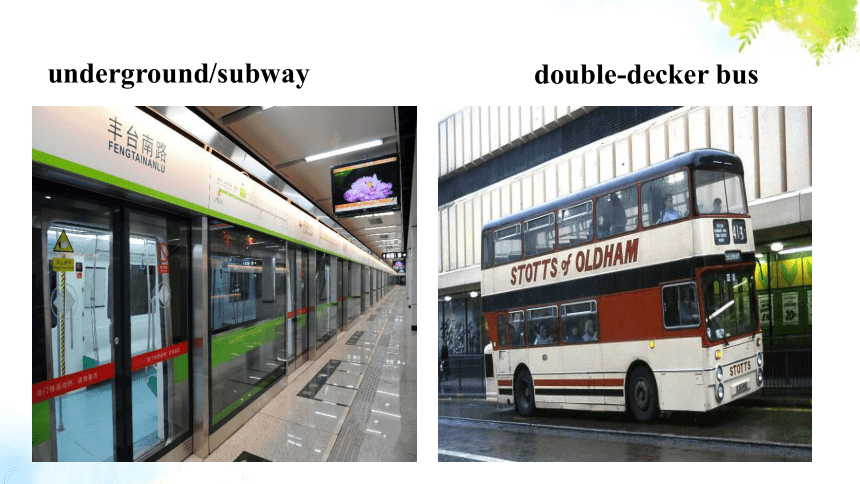

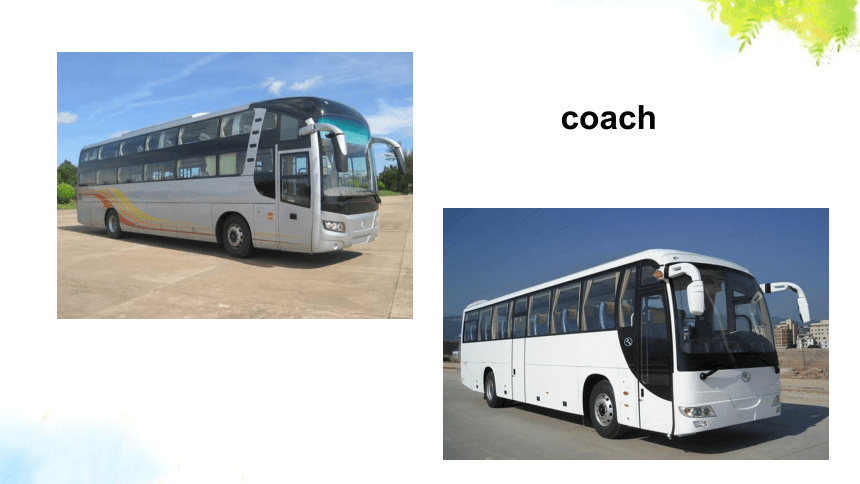

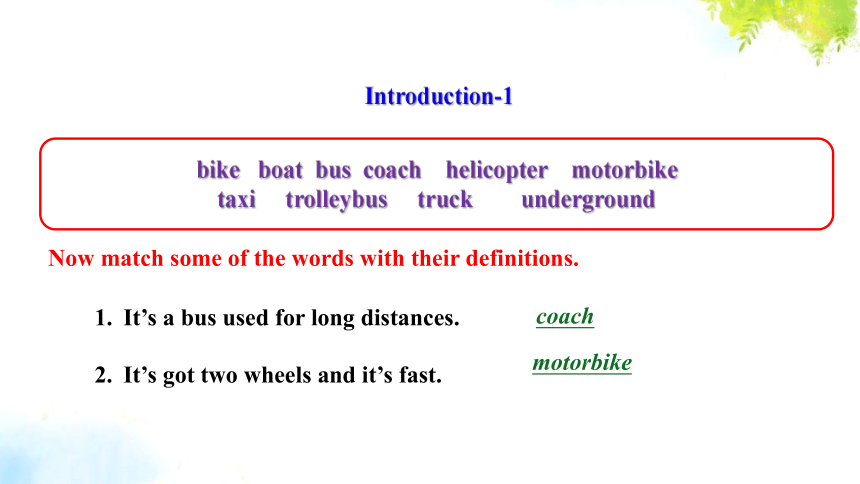

文档简介
(共29张PPT)
必修4
Introduction﹠ Reading and Vocabulary
Module 2 Traffic Jam
What do you think of these pictures
Introduction
means of transport
bike
bus
ship
helicopter
motorbike
taxi
train
Leading in
Look at the following means of transport. Can you give their names
underground/subway
double-decker bus
air-conditioned bus
coach
minibus
trolleybus
pedicab
bike boat bus coach helicopter motorbike
taxi trolleybus truck underground
It’s a bus used for long distances.
It’s got two wheels and it’s fast.
Now match some of the words with their definitions.
coach
motorbike
Introduction-1
bike boat bus coach helicopter motorbike
taxi trolleybus truck underground
3. This bus is connected to electric wires.
4. You must pay to use this car.
5. This is a suburban railway. It’s usually under the city.
6. it’s slow, cheap and has two wheels.
trolleybus
taxi
underground
bike
If you have a chance to travel on holiday, where do you want to go
Question
Getting Around in Beijing
travel 旅行
Reading
The Forbidden City
The White
Pagoda
(in Beihai Park)
Fast Reading
Ⅰ. Read the passage quickly and find out what means of transport are mentioned in the text.
_____________________________________________________
Ⅱ. Which is a proper means of transport when you travel a long way without costing too much
_____________
Taxis, buses, trolleybuses, minibuses, underground, pedicabs.
Underground.
Fast-reading
Read the passage quickly and answer the questions.
How easy is it to find a taxi in Beijing
2. What colour are most taxis
3. what’s the problem with buses
Raise your hand, and a taxi appears in no time.
They’re red.
They’re often very crowded.
Read the passage quickly and answer the questions.
4. Which is the best bus for tourists
5. How many people can get in a minibus
6. What are the advantages of the underground
7. When does it close at night
8.What can you visit in a pedicab
The 103 bus.
12 people.
It’s fast and convenient.
It closes at 11:00 pm.
The narrow alleys of old Beijing.
Careful-reading
Match the words in the box with their meanings.
1
cab destination fare get around passenger permit (n) receipt return (n) route rush hour seat single (n)
2 a person who uses public transport
1 to go from one place to another
3 (a ticket for) a two-way journey
4 the road the public transport service uses regularly
5 the busiest time of day
route
6 the price of a ticket
get around
passenger
return
rush hour
fare
7 (a ticket for) a one-way journey
8 the place you want to go to
9 a document which shows you have paid for something
10 a place to sit
11 another word for taxi
single
destination
receipt
seat
cab
12 a document which gives you the right to do something
permit
means of transportatin Time limits advantages disadvantages
Taxis
Buses/trolleybuses
minibuses
underground
pedicabs
Ⅲ complete the table
24 hours a day
fast ;
convenient
expensive
From 5 am to midnight
cheap
crowded
have a seat for everyone
more expensive
From 5 am to 11 pm
fast; convenient
crowded during rush hours
Useful for
exploring the
narrow alleys
expensive
3. Read the passage carefully and choose the correct answers.
1. If you want to explore the narrow alleys of old Beijing, you should choose _______ .
A. taxis
B. minibuses
C. pedicabs
D. underground
2. The rush hour includes _______ .
A. 6: 30 a. m. —8: 00 a. m. and 5: 00 p. m. —6: 30 p. m.
B. 4: 00—5: 30 in the afternoon
C. 5: 30—8: 00 in the morning
D. 8: 00 a. m. —9: 00 a. m.
3. Tourists shouldn’t miss the 103 bus because _______ .
A. the fare is cheap, at 1 yuan
B. they always get a seat even in rush hours
C. it is fast and convenient
D. it offers one of the most impressive routes
4. When you take a taxi in Beijing, you should _______ .
A. bargain with the driver
B. check the business permit and ask for a receipt
C. talk to the driver
D. define the price per kilometre
5. If you want to see the Forbidden City and the White Pagoda in Beihai Park, you’d better take _______ .
A. buses numbered 1 to 100
B. the 103 bus
C. buses with a number in the 200s
D. a taxi
Simply raise your hand, and a taxi appears _____________.
Public transport _________ a cheap way to ______________ in Beijing.
There are 20,000 buses and trolleybuses in Beijing, but they can _____ very ________.
Buses __________1 to 100 are ________ to travel within the city centre.
in no time
provides
get around
get
crowded
numbered
limited
Fill in the blanks with the words in the passage.
6.If you get on a double-decker bus, make sure you sit upstairs. You’ll _________________the rapidly changing city.
7. However, there is also a night bus service,_________ by buses with a number in the 200s.
8.Minibuses with seat for 12 passengers offer an ___________ to expensive taxis and crowded public transport in some areas.
have a good view of
provided
alternative
5.Tourists shouldn't miss the 103 bus which offers one of the most ____________ routes,_______ the Forbidden City and the White Pagoda in Beihai Park.
impressive
past
11. Trains are fast and convenient , but rush hours ______be terrible.
12. Station names are _______ in pinyin.
13.Tricycles are ______________ if you want to _________ the narrow alleys of old Beijing.
marked
worth using
explore
10. There are four underground lines in Beijing, and several lines are______________.
can
under construction
9. They run regular services and follow the same routes _____ large public buses.
as
必修4
Introduction﹠ Reading and Vocabulary
Module 2 Traffic Jam
What do you think of these pictures
Introduction
means of transport
bike
bus
ship
helicopter
motorbike
taxi
train
Leading in
Look at the following means of transport. Can you give their names
underground/subway
double-decker bus
air-conditioned bus
coach
minibus
trolleybus
pedicab
bike boat bus coach helicopter motorbike
taxi trolleybus truck underground
It’s a bus used for long distances.
It’s got two wheels and it’s fast.
Now match some of the words with their definitions.
coach
motorbike
Introduction-1
bike boat bus coach helicopter motorbike
taxi trolleybus truck underground
3. This bus is connected to electric wires.
4. You must pay to use this car.
5. This is a suburban railway. It’s usually under the city.
6. it’s slow, cheap and has two wheels.
trolleybus
taxi
underground
bike
If you have a chance to travel on holiday, where do you want to go
Question
Getting Around in Beijing
travel 旅行
Reading
The Forbidden City
The White
Pagoda
(in Beihai Park)
Fast Reading
Ⅰ. Read the passage quickly and find out what means of transport are mentioned in the text.
_____________________________________________________
Ⅱ. Which is a proper means of transport when you travel a long way without costing too much
_____________
Taxis, buses, trolleybuses, minibuses, underground, pedicabs.
Underground.
Fast-reading
Read the passage quickly and answer the questions.
How easy is it to find a taxi in Beijing
2. What colour are most taxis
3. what’s the problem with buses
Raise your hand, and a taxi appears in no time.
They’re red.
They’re often very crowded.
Read the passage quickly and answer the questions.
4. Which is the best bus for tourists
5. How many people can get in a minibus
6. What are the advantages of the underground
7. When does it close at night
8.What can you visit in a pedicab
The 103 bus.
12 people.
It’s fast and convenient.
It closes at 11:00 pm.
The narrow alleys of old Beijing.
Careful-reading
Match the words in the box with their meanings.
1
cab destination fare get around passenger permit (n) receipt return (n) route rush hour seat single (n)
2 a person who uses public transport
1 to go from one place to another
3 (a ticket for) a two-way journey
4 the road the public transport service uses regularly
5 the busiest time of day
route
6 the price of a ticket
get around
passenger
return
rush hour
fare
7 (a ticket for) a one-way journey
8 the place you want to go to
9 a document which shows you have paid for something
10 a place to sit
11 another word for taxi
single
destination
receipt
seat
cab
12 a document which gives you the right to do something
permit
means of transportatin Time limits advantages disadvantages
Taxis
Buses/trolleybuses
minibuses
underground
pedicabs
Ⅲ complete the table
24 hours a day
fast ;
convenient
expensive
From 5 am to midnight
cheap
crowded
have a seat for everyone
more expensive
From 5 am to 11 pm
fast; convenient
crowded during rush hours
Useful for
exploring the
narrow alleys
expensive
3. Read the passage carefully and choose the correct answers.
1. If you want to explore the narrow alleys of old Beijing, you should choose _______ .
A. taxis
B. minibuses
C. pedicabs
D. underground
2. The rush hour includes _______ .
A. 6: 30 a. m. —8: 00 a. m. and 5: 00 p. m. —6: 30 p. m.
B. 4: 00—5: 30 in the afternoon
C. 5: 30—8: 00 in the morning
D. 8: 00 a. m. —9: 00 a. m.
3. Tourists shouldn’t miss the 103 bus because _______ .
A. the fare is cheap, at 1 yuan
B. they always get a seat even in rush hours
C. it is fast and convenient
D. it offers one of the most impressive routes
4. When you take a taxi in Beijing, you should _______ .
A. bargain with the driver
B. check the business permit and ask for a receipt
C. talk to the driver
D. define the price per kilometre
5. If you want to see the Forbidden City and the White Pagoda in Beihai Park, you’d better take _______ .
A. buses numbered 1 to 100
B. the 103 bus
C. buses with a number in the 200s
D. a taxi
Simply raise your hand, and a taxi appears _____________.
Public transport _________ a cheap way to ______________ in Beijing.
There are 20,000 buses and trolleybuses in Beijing, but they can _____ very ________.
Buses __________1 to 100 are ________ to travel within the city centre.
in no time
provides
get around
get
crowded
numbered
limited
Fill in the blanks with the words in the passage.
6.If you get on a double-decker bus, make sure you sit upstairs. You’ll _________________the rapidly changing city.
7. However, there is also a night bus service,_________ by buses with a number in the 200s.
8.Minibuses with seat for 12 passengers offer an ___________ to expensive taxis and crowded public transport in some areas.
have a good view of
provided
alternative
5.Tourists shouldn't miss the 103 bus which offers one of the most ____________ routes,_______ the Forbidden City and the White Pagoda in Beihai Park.
impressive
past
11. Trains are fast and convenient , but rush hours ______be terrible.
12. Station names are _______ in pinyin.
13.Tricycles are ______________ if you want to _________ the narrow alleys of old Beijing.
marked
worth using
explore
10. There are four underground lines in Beijing, and several lines are______________.
can
under construction
9. They run regular services and follow the same routes _____ large public buses.
as
